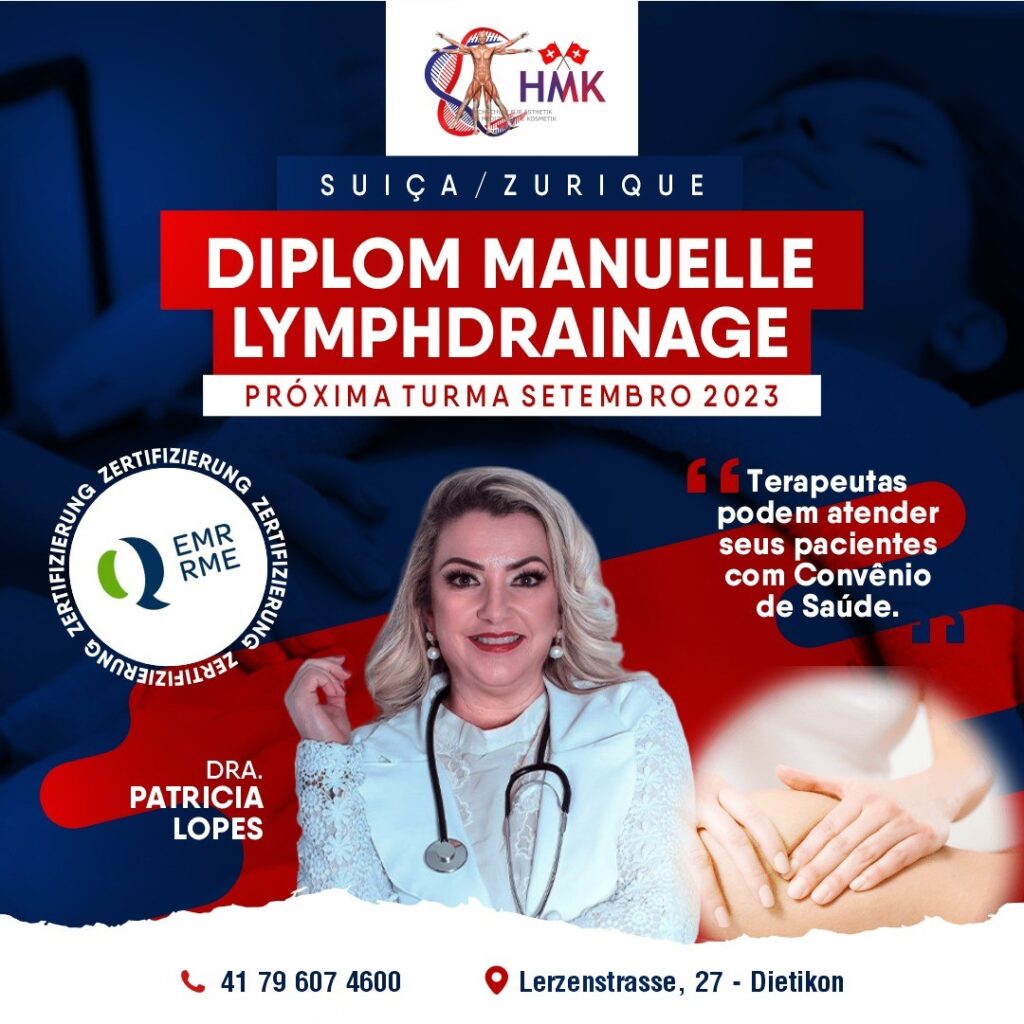- +41 79 607 46 00
- info@hmkeducation.com
- Lerzenstrasse 27, 8953 Dietikon
DIPLOMA IN LYMPHATIC THERAPY

- Category: Professional Courses
Course Description
A Brief History of Manual Lymph Drainage
Since the creation of the manual lymphatic drainage technique by the Danish biologist Emil Vodder and his wife Estrid Vodder in 1936, many followers have spread it, making it one of the mainstays in the treatment of lymphedema1-5. This technique was based on the long experience gained by Emil Vodder and his wife with massage techniques in Cannes, on the French Riviera. They observed that many people had chronic colds in which an increase in lymph nodes in the cervical region was detected. They were able to improve these conditions with certain types of physical stimulation movement (massage) performed on the area involved. Based on these observations, the technique of manual lymphatic drainage was developed, with the systematization of certain types of movements and the orientation of the direction of drainage.
In 1936, the technique was published in Paris and, from this dissemination, various groups assimilated these concepts, which are still used today. Initially, the technique was disseminated at aesthetics congresses, and was performed by aestheticians, biologists and other professionals who were adept at it. In recent years, with the incorporation of manual lymphatic drainage as an important part of the treatment of lymphedema, doctors have begun to encourage physiotherapists and other related professionals, such as occupational therapists and nurses, to practice it. Among the doctors who began using the technique, Asdonk's work in 1963 stands out, as he incorporated lymphatic drainage as part of medical treatment, initiating a series of contributions to the procedure6. In mid-1967, the Society for Manual Lymphatic Drainage was created, which, from 1976, was incorporated into the German Lymphology Society6. Among the main groups using the technique are: Földi, Leduc, Casley-Smith, Nieto, Ciucci, Beltramino, Mayall and others. We should point out that these groups have added their own individual contributions, especially in the treatment of patients with lymphedema, but have maintained the principles advocated by Vodder. Among the main contributions is that of Földi, who advocated the combination of lymphatic drainage, bandages and hygienic care. This technique became known as Földi's complex physical therapy3.
What are the benefits of manual lymphatic drainage?
- Helps combat and prevent swelling and fluid retention;
- Prevents the formation of cellulite;
- Eliminates toxins from the body;
- It helps in the healing process of injuries and in recovery from plastic surgery;
- Improves blood, venous and lymphatic circulation;
- Contributes to better oxygenation of the body.
Contraindications and Special Care
In some cases, lymphatic drainage can worsen a health problem. That's why it's important to always be aware of contraindications and, if in doubt, talk to a doctor about it. Check out the situations in which drainage is not recommended:
- People who have severe acne on their skin should avoid lymphatic drainage, as the movement of the massage can worsen the lesions;
- Bruises or open wounds can also develop into inflammation if the person undergoes drainage treatment.
The procedure can be a great ally in recovery after surgical procedures, but it is essential to have a medical opinion that tells you the right time to start the sessions without risking anything.
Women who have had their lymph nodes removed after a breast cancer diagnosis can also have drainage, but in these cases you need to be careful and check with your doctor how the procedure can be carried out, as a poorly applied technique can be extremely harmful to the patient.
Proper lymphatic drainage can play a restorative role in the body's functions, eliminating toxins, preventing swelling and significantly improving the appearance of the skin. The important thing is to have the procedure carried out by qualified professionals who guarantee safety and the desired results.
The Criteria for Training in Manual Lymphatic Drainage;
Any professional who wants to learn the technique, as well as therapists.
FINAL EXAM :
Test of theoretical knowledge and presentation of a clinical case with diagnosis and treatment.
Objective of the Manual Lymphatic Drainage Course
Provide students with knowledge of the anatomy and physiology of the lymphatic and circulatory systems, as well as how to use the manual lymphatic drainage technique correctly on their patients without harming them.
This helps improve edema and the autoimmune system.
It is used in various fields, both at hospital level, for example in the treatment of post-surgical oedema, and at aesthetic level due to its recognized decongestant and anti-dematous properties.
This way, trained students will have opportunities in a variety of fields in the very competitive job market.
Instructor

Dr. Patricia Munhoz Lopes
Dr. Patricia M. Lopes Bachelor in Physiotherapy, specialist in Osteopathy. Teaching experience for over 25 years. National and international speaker in several countries
-
Workload: 371 hours (including exam hours)
215 hours of Academic Medical Training 150 hours of Specialized Training in the Manual Lymphatic Drainage Technique. - Language: Portuguese, English, German and Italian
- Date: Starts September 27, 2023
- Classes once a week, every Wednesday
- Certificate: Yes (Recognition in RME)
- Location: Lerzenstrasse 27, 8953 Dietikon
- Theoretical Classroom and Practical Internships
Course Content
-Cytology
-Histology
-Bones/Musculoskeletal system passive
-Muscles/active skeletal muscle system
-Lymphatic System
-Cardiovascular System
-Respiratory System
-Digestive System
-Uro Genital System
-Hormonal System
-Sensory Organs
-Nervous System
-Physiopathology -Active skeletal muscle system
-Passive skeletal muscle system
-Lymphatic System
-Cardiovascular System
-Respiratory System
-Digestive System
-Uro Genital System
-Hormonal System
-Sensory Organs
-Nervous System0
-After treatment in surgical procedures
-Diagnosis /Anamnesis/Inspection
-Registration and results
-Examination techniques
-Organ-specific examination method
-Physical examination method
-Pain problem
–
Blood pressure,
Pulse measurement
-Topographical results/terms
-Medical Report
–
-Theory of Infection
-Therapist/patient hygiene measures
-Hygiene measures in practice
-The body's defense system
-Theory of Infection
-Hygiene plans
-Disinfection Theory/
Sterilization
-Epidemic/Pandemic
-Mortality
-First Aid
-Emergency measures
- Case studies
-Introduction to Psychology
-Typology
-Psychosomatics
-Action Phases
Psychology
-Transactional Analysis
-Work environment/team spirit
-Active listening
-Conversation techniques
and Communication
Basics of manual lymphatic drainage and compression dressings
-History of physical therapy for edema
-General and physiological anatomy of blood circulation
and the lymphatic system
-Mechanism of action of manual lymphatic drainage
-indications and contra-indications for manual lymphatic drainage and compression dressings
-Procedural principles for manual lymphatic drainage /basic adherence techniques/treatment of individual parts of the human body
-Treatment techniques / structures
-Functional anatomy and physiology of the lymphatic system
-In-depth study of the general pathology of the lymphatic system
-Extension of adherence techniques in manual lymphatic drainage
-Compression dressing basics / compression dressing treatments
-indications and contraindications for post-traumatic and post-operative conditions
–
- Lymphology
-Physiopathology /clinical/
-Special classifications of edema /degrees /procedures and diagnostics /indications and contraindications
-indications and contraindications for edema /
standardized volume and circumference measurements
and documentation of edema
-Treatment in relation to pathology / interdisciplinarity/expansion of measures
-Case studies (theoretical and Communication of measures, treatments in relation to pathology, indications and contra-indications, documentation and evaluation and treatment.
-Special classification of edema / degrees / diagnostic procedure / indications and contraindications
-Edema measurements (Standardized measurement of edema volume and circumference.
-Treatment in relation to pathology / interdisciplinarity / and expansion of measures
-Dealing with case studies, theoretical background and communication
treatment evaluation .
-Different important authors in lymphatic drainage techniques, such as Vodder, Foldi, Leduc and Godoy.


